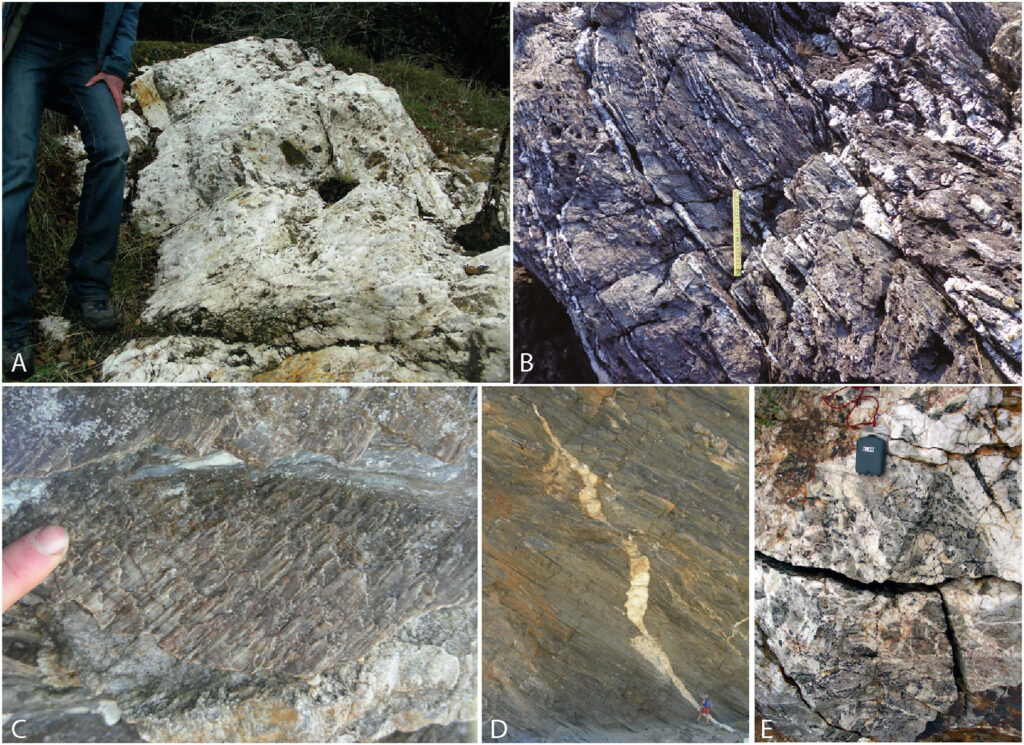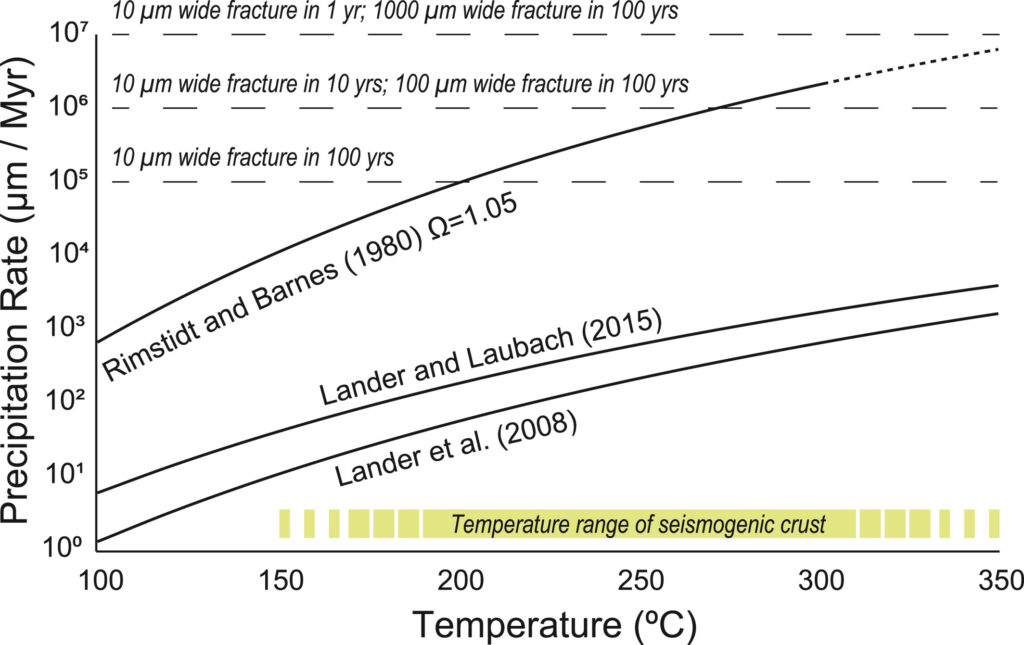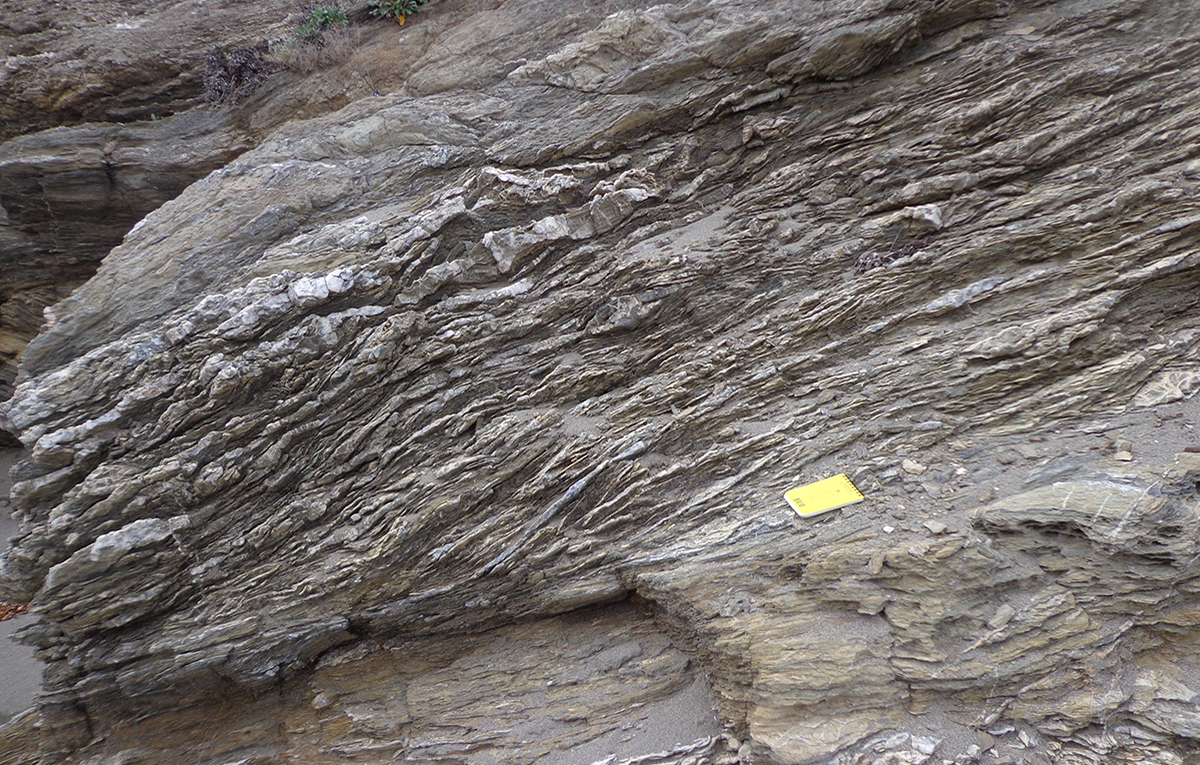Editors’ Vox is a blog from AGU’s Publications Department.
During an earthquake, the strength of a fault decreases dramatically and instantaneously. Afterwards the fault “heals” and regains its strength, but the speed and mechanism of this healing process is not well understood. A recent article published in Reviews of Geophysics explores the role that quartz cementation may play in fault healing. We asked the authors to give an overview of what we know and don’t know about fault healing and quartz cementation.
In simple terms, what is “fault healing”?
A variety of physical and chemical processes occur within fault zones during and after earthquake slip. During slip, most of these processes act to promote slip acceleration by dramatically decreasing the fault’s resistance to further shear (i.e. its “strength”) over time scales of seconds to minutes. Because earthquake-producing faults slip in a punctuated manner through time, however, we can infer that at least some of that strength is recovered following individual earthquakes. That recovery of pre-failure fault strength (be it partial or complete) between earthquakes is referred to as “fault healing”.
Recovery of pre-failure fault strength (be it partial or complete) between earthquakes is referred to as “fault healing”.
What processes cause faults to heal?
The exact mechanisms of fault healing, as well as the magnitude of their effects and time scales of operation in the crust, are a subject of active debate in the earthquake mechanics community. There is general agreement that both physical and chemical mechanisms likely play some role, and that the relative contribution of different mechanisms almost certainly varies with temperature, pressure, and the bulk chemistry of the system (i.e. the composition and properties of both rocks and local fluids within the fault zone) at different depths within the earthquake-producing crust.
How do scientists observe and measure fault healing?
Fault healing has been observed in nature predominately through geophysical methods. Seismological studies have shown that the seismic velocity of fault zones in the shallow crust generally increases over months to years following earthquake ruptures, and these increases are inferred to reflect healing associated with the progressive closure of cracks/fractures produced during slip.
Geodetic measurements relying on strategically deployed networks of high-precision GPS exhibit changes in the relative rates of plate motion across faults through time following earthquakes, which are typically inferred to record “re-locking” of the fault surface at greater depths during healing.
Laboratory deformation experiments of materials commonly found within fault zones have also documented increases in shear resistance/strength between individual slip increments, including a progressive increase in strength with ‘hold time’, allowing insight into some of the physical mechanisms governing healing over relatively shorter time scales of days to months.
What is “quartz cementation” and where does it most commonly occur?
Quartz cementation is a process by which quartz is precipitated from an aqueous fluid, specifically in a manner that bonds or “cements” adjacent grains in a rock or sediment mass. This process is exponentially dependent on temperature (i.e. it is “kinetically controlled”), and as a result the prevalence of quartz cements typically increases with increasing depth/temperature in the crust. In fault zones exhumed from near the base of the earthquake-producing crust (i.e. 10 to 15 kilometers in continental crust but deeper in subduction zones), extensive networks of quartz-sealed fractures (veins) are relatively common, indicating that the process of quartz cementation is rapid at those depths when compared with shallower portions of the crust.
How does quartz cementation promote fault healing?
The process of fault slip results in fracturing of rocks within fault zones at scales from microns to meters, leading to dramatic reductions in their cohesive strength. Quartz cementation effectively acts to repair fracture damage at all scales by rebonding the rock mass between adjacent grains and/or fracture walls, thus recovering cohesive strength. The extensive action of quartz cementation and associated healing in fault zones is evident from outcrop and microstructural examination of fault-localized vein systems and has also been reproduced in laboratory deformation experiments (albeit at unrealistically high temperatures to facilitate cementation over laboratory time scales).

Can fault healing by quartz cementation impact the seismic cycle?
Although the commonality of quartz cements and inferred strength recovery in fault zones is not disputed, the link between quartz cementation and the seismic cycle implies a specific time scale over which this process occurs. More specifically, for quartz cementation to impact the seismic cycle, a sufficient volume of cements must form to result in at least partial sealing of slip-related fractures over time scales that are shorter than a typical interseismic period (i.e. a few hundred years or less in many seismogenic faults). The earthquake mechanics community has argued that a variety of different mechanisms specific to fault zones may allow for extensive quartz cementation and associated healing over such short time scales, but few have been analyzed in detail.
Our work was the first critical review and theoretical analysis of these mechanisms, which we combined with a variety of constraints on relevant empirical processes from the primary literature. We conclude that healing by quartz cementation, although commonly invoked, is most easily explained in very low porosity fracture systems along fault interfaces, while cementation of more extensive vein systems in fault zones requires conditions that are rarely achieved if currently known empirical relations are correct.
What are some of the unresolved questions where additional research, data, or modeling are needed?
Arguably the central gap in our understanding of quartz cementation and associated healing in fault zones is the lack of detailed empirical constraints on rates of quartz precipitation. A small number of studies have managed to constrain approximate quartz precipitation rates in fractures in sedimentary basins at shallow (i.e. 3 to 4 kilometer) depths, but those constraints pertain to near-equilibrium conditions that are unlikely to be applicable in seismogenic fault zones. Those rates also are unanimously too slow to explain interseismic healing, which appears to require disequilibrium conditions.

The source(s) of silica during fault-zone cementation are similarly not well constrained from the rock record but may provide useful insight in terms of the operative length scales of fluid flow pathways, mass balance, and associated feedbacks on quartz cementation.
Finally, additional hydrothermal synthesis experiments examining the detailed kinetics of quartz cementation at conditions reflective of the earthquake-producing crust would likely be informative.
— Randolph T. Williams ([email protected]; ![]() 0000-0002-1160-8842), University of Wisconsin–Madison, USA; and Åke Fagereng (
0000-0002-1160-8842), University of Wisconsin–Madison, USA; and Åke Fagereng (![]() 0000-0001-6335-8534), Cardiff University, UK
0000-0001-6335-8534), Cardiff University, UK
Editor’s Note: It is the policy of AGU Publications to invite the authors of articles published in Reviews of Geophysics to write a summary for Eos Editors’ Vox.

